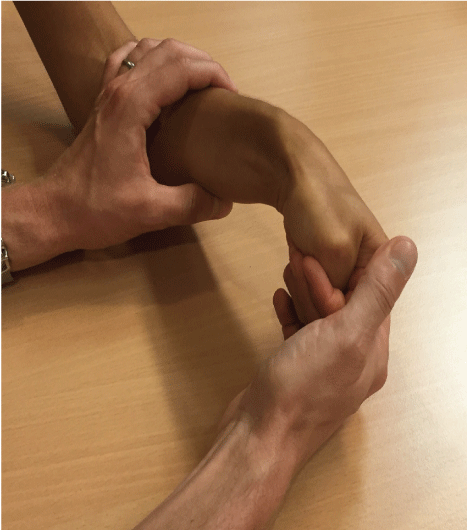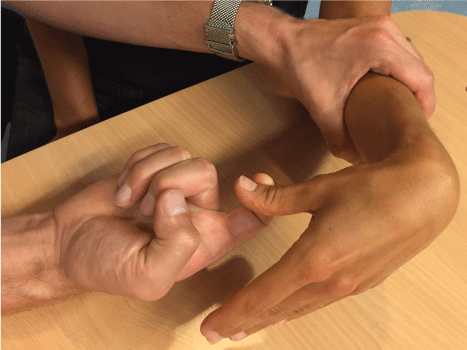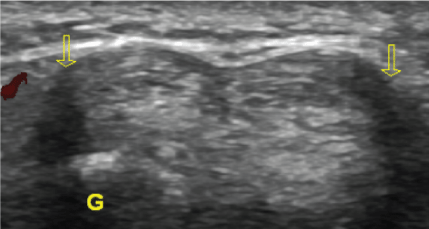De Quervain Tenosynovitis in a 12-Year-Old Child: A Generation's Disease?
Abstract
We reported a case of 12-years-old girl with isolated pain in of the left wrist. The problem had lasted for 5 weeks after a trauma, and was getting worse. Wrist X-ray was obtained, and no abnormalities were appreciated. The diagnosis after clinical and echo graphic examinations was a De Quervain's tenosynovitis which has never been reported before in pediatric orthopedic literature. After a four-week immobilization and NSAID usage, the patient was pain free. The excessive mobile phone use with active texting probably increases the problem. Repetitive movements and strain injuries of the thumb and wrist can produce musculoskeletal problems of the upper limb as De Quervain's disease. The purpose of this report is to make the physicians aware of this problem that may be common in the future, especially in the young population.
Keywords
Tenosynovitis, De Quervain, Children, Ultrasound
Introduction
Tenosynovitis of the thumb is a common diagnosis in hand surgery, historically described in 1895 by Fritz De Quervain [1]. Usual complain is pain in the first extensor compartment of the wrist, exacerbated by thumb movement and ulnar deviation of the wrist. It is associated with repetitive thumb movements, especially abduction. Its prevalence is about 0.5% in men and 1.3% in women with peak prevalence among those in their forties and fifties. Bilateral involvement is often reported in new mothers [2]. Its exact etiology is not totally clear. It might be due to an acute trauma or it may more commonly be the result of cumulative microtrauma. Rather than acute inflammation of the synovial lining, it has been histologically attributed to myxoid degeneration with fibrous tissue deposit and increased perfusion, causing tendon sheath thickening and tendons entrapment. Recently, its association with texting has been shown [3]. Tenosynovitis is very rare in children due to a young and soft tendon which does well with the tension. A high index of suspicion is needed to avoid missing such an injury. We report radiological findings, the orthopaedic following and the clinical outcome in a case of De Quervain tenosynovitis in a 12-years-old girl.
Case Report
A right-handed 12-years-old girl presented herself with persistent pain of her left wrist after a trauma on her hand five weeks before. Clinical history revealed compression of the left wrist 3 years ago without any apparent clinical effect few weeks after the past trauma. Physical examination showed tenderness on the radial styloid with a limitation of the range of motion of the radial and ulnar deviation: 20º-0º-20º (movements became painful after 20 degrees of ulnar deviation) and full active flexion of the wrist was paint full but without flexion-extension limitation (85º-0-75º). There was neither limitation of the pronation/supination (90º-0-90º). Carpometacarpial joint and metacarpophalangeal joint of the thumb were without abnormalities. Radiographs of the wrist showed no abnormalities according to her age. Initial diagnosis was a sprain of the wrist. Treatment was an immobilisation in an antebrachial cast (without fixation of the metacarpophalangeal joint) for 2 weeks with Non-Steroidal Anti-Inflammatory Drugs (NSAID) if needed. Two weeks later, complaints of wrist pain located on the radial styloid were persistent. The mother of the patient explained frequent use of the patient's thumb due to major texting with her smart phone. Physical isometric examination showed a painful palpation on the left extensor pollicis brevis and the left abductor pollicis longus tendons. Eichoff's test (Figure 1) and WHAT [4] test (Figure 2), both were positive. Regarding to the young age of the patient and normal radiographs, the differential diagnosis of osteoarthritis was excluded. Ultrasound showed a difference of calibre of the tendon (delimited between the stars) just after the first extensor tendon compartment on the longitudinal images (Figure 3) and an increase of the hypo-echogenic zones (shown by the yellow arrows) surrounding the tendon on the transverse images (Figure 4), concluding in a clinical De Quervain tenosynovitis with ultrasonographic signs of peri-focal hyper-perfusion [5] (thickening of the tendon sheath). The missed diagnosis of a De Quervain tenosynovitis was established. Due to the young age of the patient and the good results of immobilisation in addition to systemic anti-inflammatory treatment [6], we opted for another two-week strict immobilization by an antebrachial cast with the first metacarpophallangeal joint blocked in neutral position associated with NSAID. (Ibuprofen according to her weight three times a day). After two other weeks, the plaster was removed and the patient was relieved from any pain enabling her to resume usual daily activities. Physical examination was unspecific and all predictive tests were negative. The followed treatment was a three part component with physiotherapy (muscle stretching and massage), anti-inflammatory treatment in case of pain and an additional sport exemption for four weeks. Three months after the first symptoms, examination showed no limitation of the range of motion, a pain free palpation off the first dorsal wrist extensor compartment and all predictive tests stayed negative.
Discussion
De Quervain tenosynovitis is frequent in adults but an extremely rare entity in children. Clinical history should be aware of texting frequency in this new mobile phone generation [7]. Children are incomplete in physical development, so overuse of smart phones will cause negative effects on their physical development. Recent studies have shown a clear relation between texting with a phone and thumb tendons pain or histological modifications [7,8]. The clinical examination is clear and ultrasonographic assessment might be mandatory for such patient in order to confirm the right diagnosis [5]. The first-line treatment we proposed, according to up-to date guidelines, was immobilisation with a cast [6-9]. There was no need of steroid infiltration [9] which would have been the next step.
Occasional mobile phone use is almost inevitable in today's society and has no consequences on one's health. However, excessive use and mobile phone addiction rate are constantly increasing, and predict problems in the young population's physical development, such as the emergence of De Quervain tenovitis in children. Mobile phone overuse among children is likely to be continuous throughout the lifetime in our society, where smartphones become increasingly inseparable items from children. There is therefore a big effort to be made by parents and society to prevent this excess in order to fight against physical, but also personal and social loss.
Disclosure Statement
The authors have nothing to disclose.
References
- De Quervain F (1997) On a form of chronic tendovaginitis by Dr. Fritz de Quervain in la Chaux-de-Fonds. 1895. Am J Orthop (Belle Mead NJ) 26: 641-644.
- Petit Le Manac'h A, Roquelaure Y, Ha C, et al. (2011) Risk factors for de Quervain's disease in a French working population. Scand J Work Environ Health 37: 394-401.
- Ali M, Asim M, Danish SH, et al. (2014) Frequency of De Quervain's tenosynovitis and its association with SMS texting. Muscles Ligaments Tendons J 4: 74-78.
- Goubau JF, Goubau L, Van Tongel A, et al. (2014) The wrist hyperflexion and abduction of the thumb (WHAT) test: A more specific and sensitive test to diagnose de Quervain tenosynovitis than the Eichoff's Test. J Hand Surg Eur Vol 39: 286-292.
- Sato J, Ishii Y, Noguchi H (2016) Clinical and ultrasound features in patients with intersection syndrome or de Quervain's disease. J Hand Surg Eur Vol 41: 220-225.
- Lane LB, Boretz RS, Stuchin SA (2001) Treatment of de Quervain's disease: Role of conservative management. J Hand Surg Br 26: 258-260.
- Charu Eapen, Bhaskaranand Kumar, Anil K Bhat, et al. (2014) Extensor pollicis longus injury in addition to De Quervain's with text messagin on mobile phones. J Clin Diagn Res 8: 1-4.
- Akkaya N, Dogu B, Ünlü Z, et al. (2015) Ultrasonographic evaluation of the flexor pollicis longus tendon in frequent mobile phone texters. Am J Phys Med Rehabil 94: 444-448.
- Richie CA 3rd, Briner WW Jr (2003) Corticosteroid injection for treatment of de Quervain's tenosynovitis: A pooled quantitative literature evaluation. J Am Board Fam Pract 16: 102-106.
Corresponding Author
Aurélien Michel Traverso, MD, Département de l'appareil locomoteur, Centre Hospitalier Universitaire Vaudois, Service d'orthopédie et de traumatologie de l'appareil locomoteur, Avenue Pierre-Decker 4, CH-1005 Lausanne, Vaud, Switzerland.
Copyright
© 2017 Traverso AM, et al. This is an open-access article distributed under the terms of the Creative Commons Attribution License, which permits unrestricted use, distribution, and reproduction in any medium, provided the original author and source are credited.








